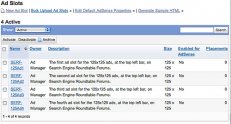If you are generating revenue off your website or blog, chances are you serve banner ads and they are either updated manually by adding the images and URLs into the source codes or with the help of external ad-serving scripts like OpenX or OIO Publishers.
Google has a similar web service, call the Google Ad Manager. In a nutshell, it is a simple (and free) web service that helps you manage banner ads. It also comes with a pretty complete inventory report module. Ad Manager integrates with AdSense, therefore webmasters have the ability to serve AdSense ads if there’s no banner for any particular slot. Here’s a quick look into advantages of Google Ad Manager:
- Ad Targeting ability. You control who get to see the ads. Let it be geographical, browser or language specific.
- Efficient ad serving. No script installation is required. Everything (including the creatives) are hosted with Google. Not only it saves you space and bandwidths, you can also be rest-assured that banners will be delivered quickly.
- Multi-user supported. You can assign multiple salespersons to handle the sales part, and have everything documented/recorded nicely inside Google Ad Manager.
- Simple User Interface. And like any other Google web services, Ad Manager has simple and easy to understand interface.
If you are convinced that Google Ad Manager is potentially helpful in managing advertisements for your website or blog, we want to show you how to get it setup right from the scratch. Full guide after jump.
1. Create Ad Slots
Ad Slots are the reserved space on your site for ad placements. If you want to insert 4 125×125 banners on your sidebr, you are looking at creating 4 ad slots. Here hongkiat.com, we have eight 125×125 image banners. That means we’ll need to repeately create 8 different ad slots. Let’s go about doing it.












